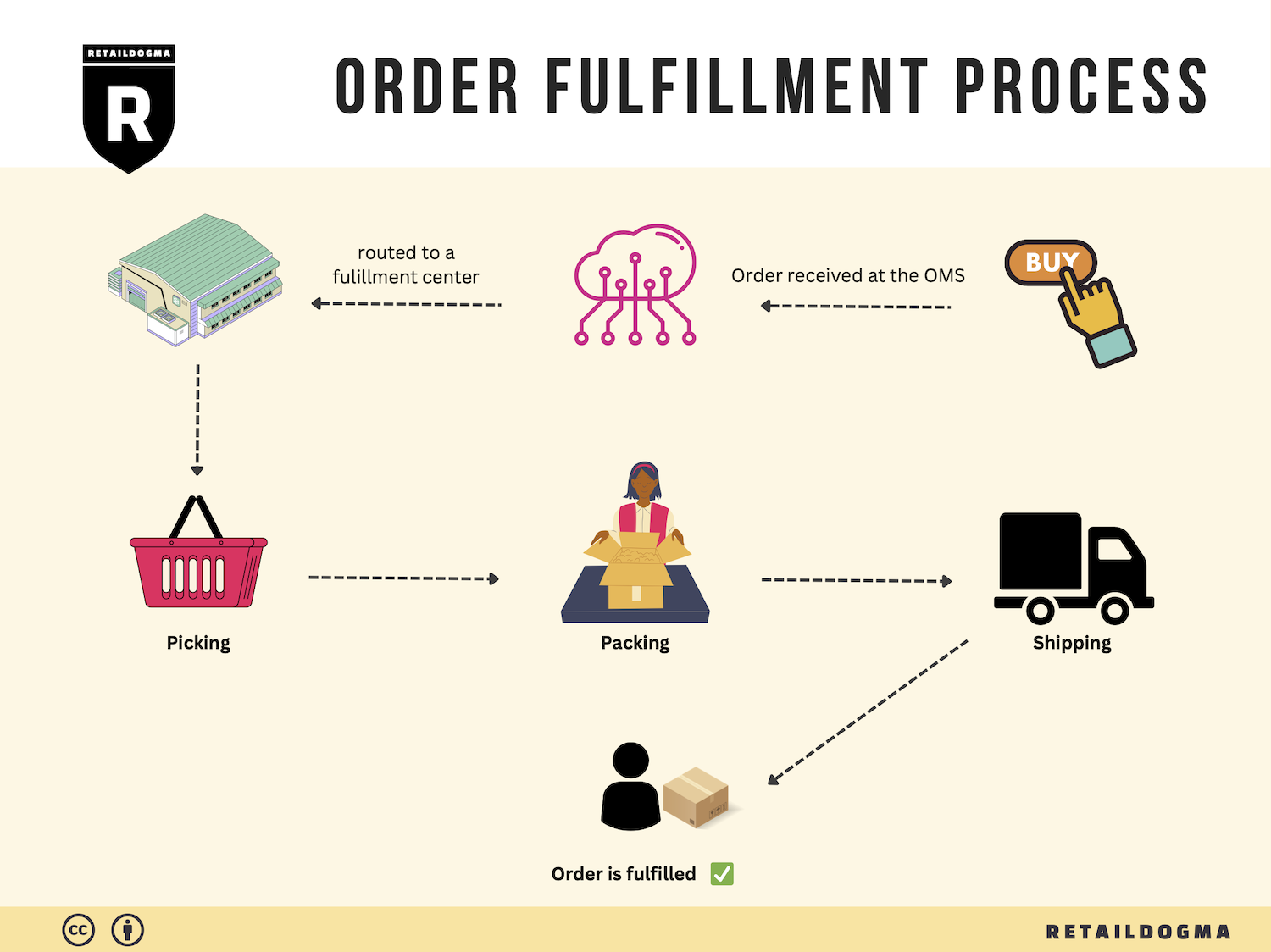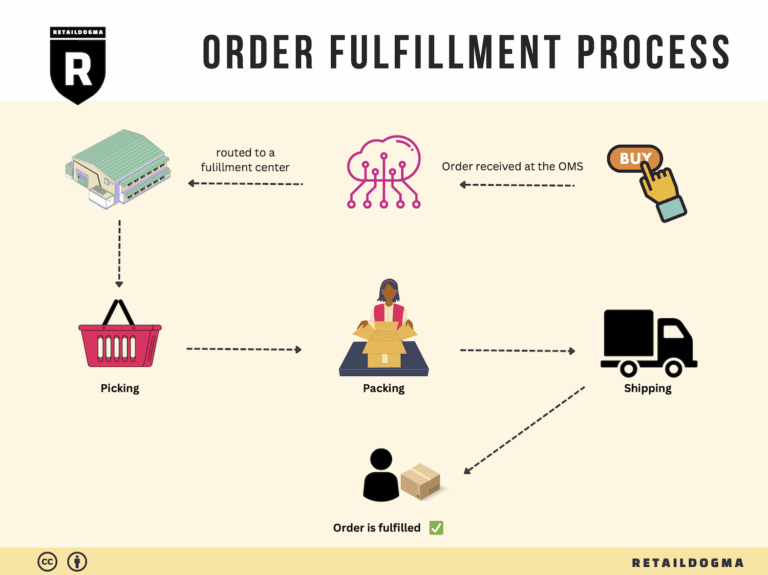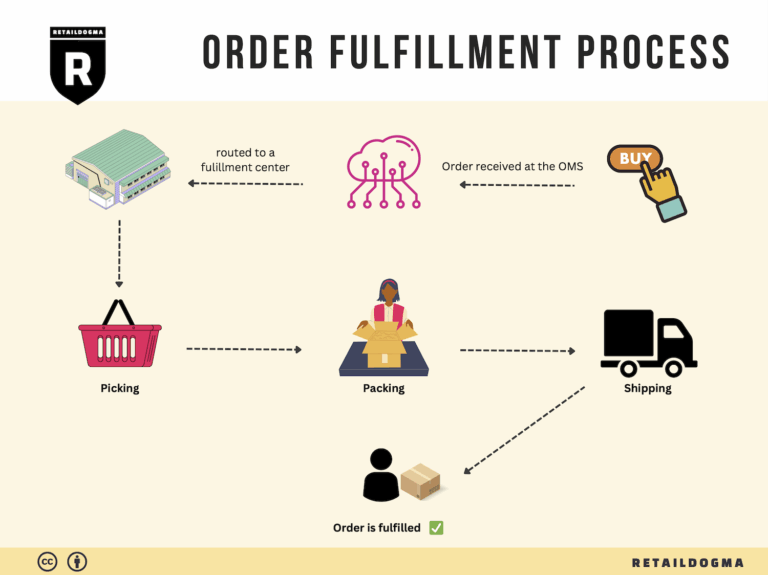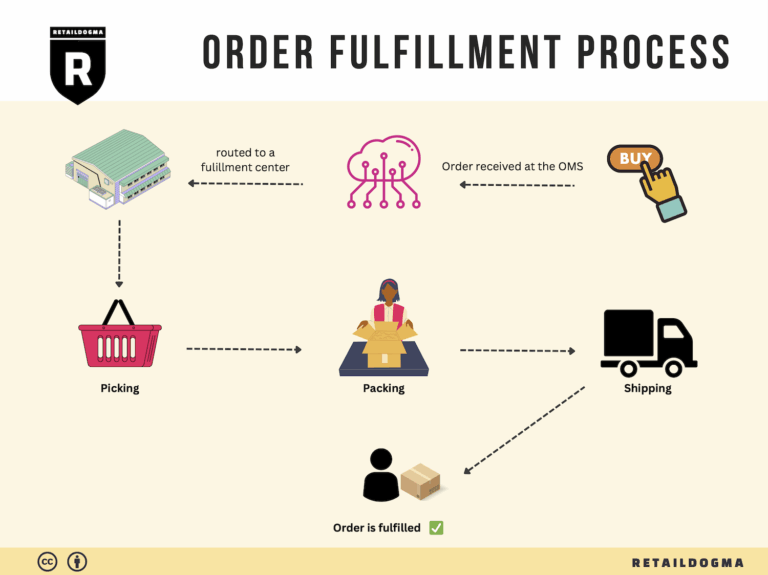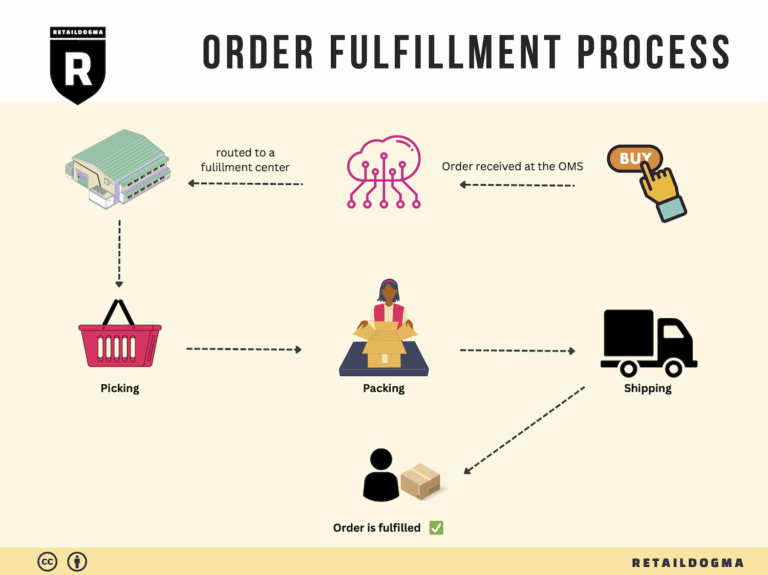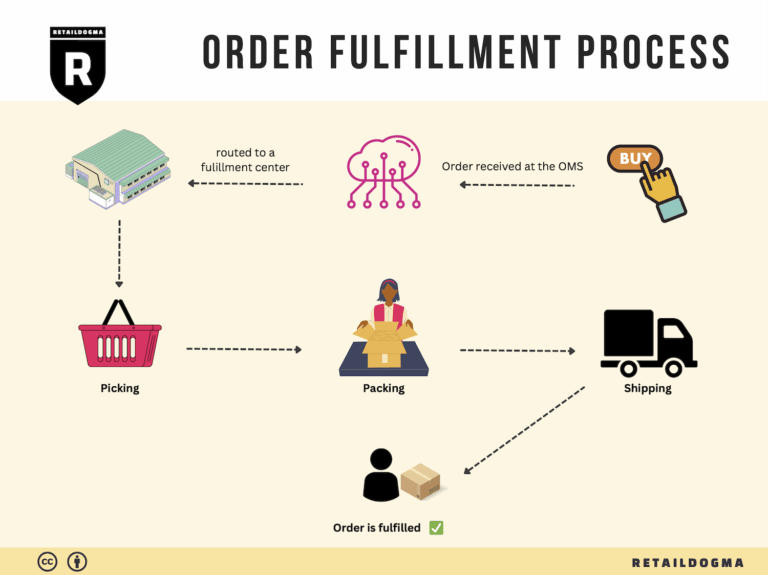What Is A Fulfillment Center? A Complete Guide (2025)
What is E-commerce Fulfillment? An Introduction for Growing Businesses
Understanding the Challenges of Order Fulfillment
As an e-commerce business owner, you likely find yourself grappling with a common challenge: the overwhelming task of packing and shipping orders. As your sales grow, so does the complexity of managing logistics. The pressure to meet customer expectations for fast and accurate deliveries can quickly escalate, diverting your focus from scaling your business to merely keeping up with order fulfillment.
At its core, e-commerce fulfillment is the process of getting a product from your inventory to your customer’s doorstep. This includes everything from managing stock levels and picking items from shelves to packing them securely and arranging for shipment. For many growing businesses, the fulfillment process can become a bottleneck that hinders growth and profitability.
What This Guide Covers
In this guide, we will demystify e-commerce fulfillment by exploring various fulfillment models available to online businesses. You will learn about:
- Third-Party Logistics (3PL): Partnering with external fulfillment providers who manage warehousing, inventory, and shipping on your behalf.
- Fulfillment by Amazon (FBA): Utilizing Amazon’s vast logistics network to handle storage, packing, and shipping, allowing you to tap into their customer base.
- Self-Fulfillment: Managing your own fulfillment process, ideal for small businesses or those with unique needs.
We will also delve into the core services offered by fulfillment providers, including inventory management, order processing, shipping logistics, and returns handling. Understanding these services will help you determine what you need as your business scales.
Choosing the Right Fulfillment Partner
Selecting the right fulfillment partner is crucial for your business’s success. This guide will provide you with insights on how to evaluate potential partners based on factors such as reliability, technology integration, and pricing structures. We’ll also cover common pricing models so you can make informed financial decisions.
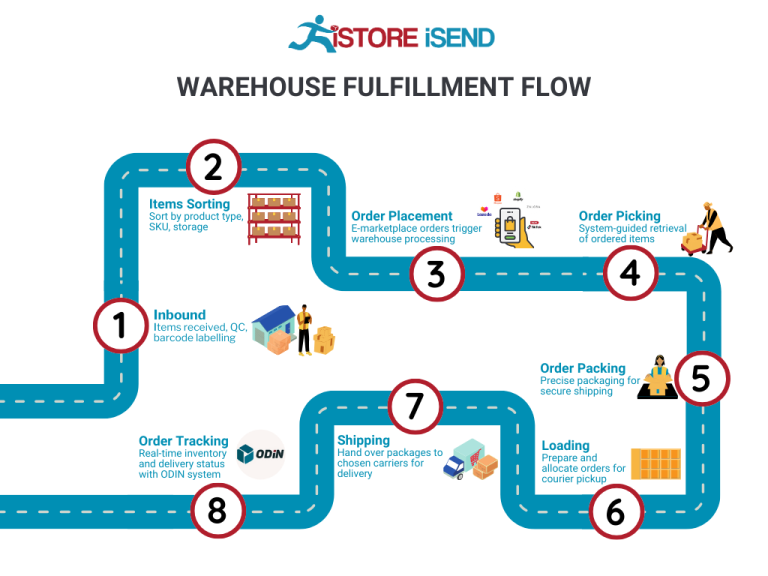
Empowering Your Logistics Decisions
Our goal with this guide is to empower you to make smart, strategic decisions regarding your logistics and fulfillment needs. By understanding the different fulfillment options available and how they can impact your business, you can streamline your operations, enhance customer satisfaction, and ultimately drive growth. Whether you’re just starting out or looking to scale, this comprehensive guide will equip you with the knowledge to navigate the complexities of e-commerce fulfillment effectively.
What You’ll Learn In This Guide
- What is E-commerce Fulfillment? An Introduction for Growing Businesses
- The Order Fulfillment Process: From ‘Buy’ Button to Customer’s Door
- Comparing Fulfillment Models: In-House vs. 3PL vs. Dropshipping
- A Deep Dive into Amazon FBA: Pros, Cons, and Who It’s For
- Core Services Offered by Fulfillment Centers
- How to Choose a Fulfillment Partner: A 6-Point Checklist
- Understanding Fulfillment Pricing: A Breakdown of Common Fees
- Frequently Asked Questions (FAQs) about Fulfillment
- Conclusion: Is Outsourcing Fulfillment the Right Move for Your Business?
- Important Disclaimer
The Order Fulfillment Process: From ‘Buy’ Button to Customer’s Door
1. Receiving Inventory
The order fulfillment process begins with receiving inventory from suppliers or manufacturers. This step involves checking incoming shipments against purchase orders to ensure accuracy in terms of quantity and quality. Each item is typically assigned a Stock Keeping Unit (SKU), a unique identifier that helps track products throughout the fulfillment process.
Importance: Proper receiving procedures are critical as they set the foundation for effective inventory management. Any discrepancies at this stage can lead to stockouts or overstock situations, which can disrupt sales and customer satisfaction. Additionally, efficient receiving minimizes the risk of errors that can complicate later stages of fulfillment.
2. Warehouse Storage
Once inventory is received, it needs to be stored in a warehouse. This involves categorizing and organizing products in a manner that maximizes space and facilitates easy access. Common practices include using a structured shelving system and implementing a Warehouse Management System (WMS) that helps in tracking inventory locations.
Importance: Effective warehouse storage is vital for operational efficiency. It reduces the time spent searching for items during order picking, thereby speeding up the overall fulfillment process. A well-organized warehouse not only enhances productivity but also minimizes the risk of damage or misplacement of inventory, which can lead to customer dissatisfaction.
3. Order Picking
When a customer places an order, the next step is order picking. This involves retrieving the items from their storage locations based on a pick list, which details the SKUs and quantities needed for the order. There are various picking methods, including single-order picking, batch picking, and zone picking, each suitable for different business needs.
Importance: Order picking is a crucial step because it directly impacts the speed and accuracy of order fulfillment. An efficient picking process reduces the time it takes to fulfill orders and enhances the likelihood of delivering the correct items to customers. Mistakes in this phase can lead to returns and increased operational costs, so it’s essential to optimize picking strategies.
4. Order Packing
After the items are picked, they are moved to the packing station. Here, products are carefully packed to ensure they are secure during transit. This process may include adding protective materials, selecting the appropriate box size, and including packing slips or branded materials for an enhanced customer experience.

Importance: Packing is not just about safeguarding products; it’s also an opportunity to reinforce your brand. A well-packaged order can create a positive unboxing experience, which is crucial for customer satisfaction and can lead to repeat business. Moreover, efficient packing practices help minimize shipping costs and improve delivery times by ensuring that packages are optimized for transport.
5. Shipping & Delivery
The final step in the fulfillment process is shipping the packed orders to customers. This involves selecting a carrier, generating shipping labels, and organizing the logistics for delivery. Factors such as shipping speed, cost, and destination play a significant role in this decision-making process. Utilizing a multi-carrier shipping strategy can help businesses optimize costs and improve delivery options.
Importance: The shipping and delivery phase is the culmination of the entire fulfillment process and is often the most visible to customers. Timely and accurate delivery can significantly influence customer satisfaction and loyalty. In today’s competitive e-commerce landscape, offering options like same-day or two-day shipping can differentiate your business and drive sales.
In summary, mastering each step of the order fulfillment process—from receiving inventory to delivering products—ensures that e-commerce businesses can scale effectively while maintaining high levels of customer satisfaction. By focusing on efficiency and accuracy at each stage, businesses can optimize their operations and create a seamless shopping experience for their customers.
Comparing Fulfillment Models: In-House vs. 3PL vs. Dropshipping
Fulfillment Model Comparison
| Model | Who Handles Inventory | Best For (Business Stage) | Key Advantage | Key Disadvantage |
|---|---|---|---|---|
| In-House Fulfillment | The business itself | Startups to small businesses | Full control over inventory and shipping processes | High overhead costs and resource-intensive |
| Third-Party Logistics (3PL) | A third-party provider | Growing to established businesses | Cost-effective and scalable logistics solutions | Less control over fulfillment processes |
| Dropshipping | Supplier/manufacturer | New businesses or niche markets | Low upfront investment and risk | Limited control over product quality and shipping |
In-House Fulfillment
In-house fulfillment is the practice where a business manages its own inventory, order processing, and shipping. This model is often favored by startups and small businesses that have unique product offerings or require specific handling for their items. The primary advantage of in-house fulfillment is the complete control it provides over the entire order process. Businesses can tailor their packing, shipping methods, and customer service to align with their brand identity. Moreover, it allows for direct oversight of inventory management, which can be crucial for companies with fluctuating stock levels or those that need to maintain strict quality control.
However, the disadvantages can be significant. Managing fulfillment in-house requires substantial resources, including warehouse space, staff, and technology for inventory management. This can lead to high overhead costs, which may not be sustainable as the business scales. Additionally, as order volumes increase, the complexity of managing logistics can become overwhelming, potentially leading to errors that could impact customer satisfaction.
Third-Party Logistics (3PL)
Third-party logistics (3PL) involves outsourcing fulfillment operations to a specialized provider. This model is ideal for growing businesses that need to scale quickly without the burden of managing logistics. 3PL providers typically operate multiple fulfillment centers strategically located to optimize shipping times and costs. They handle everything from inventory management to order processing and shipping, allowing e-commerce businesses to focus on core activities such as marketing and product development.
The key advantage of using a 3PL is the cost-effectiveness it offers. By leveraging the provider’s established infrastructure and expertise, businesses can often save on shipping costs and enjoy faster delivery times. Additionally, as sales fluctuate, 3PLs can easily adjust to changes in demand, providing flexibility that in-house operations may struggle to achieve. However, this model does have its drawbacks. Businesses may experience reduced control over the fulfillment process, which can lead to inconsistencies in service quality. It’s crucial for companies to choose a reliable 3PL partner that aligns with their operational standards and customer expectations.
Dropshipping
Dropshipping is a fulfillment model where the retailer does not hold inventory. Instead, when a customer places an order, the retailer forwards the order details to a supplier or manufacturer, who then ships the product directly to the customer. This model is particularly appealing for new businesses or those operating in niche markets, as it minimizes upfront investment and inventory risk.
One of the main advantages of dropshipping is the low barrier to entry. Entrepreneurs can start an e-commerce store without the need for significant capital to purchase inventory upfront. This flexibility allows businesses to test new products and markets with minimal financial risk. However, dropshipping also presents several challenges. Retailers often have limited control over product quality and shipping times, which can adversely affect customer satisfaction. Additionally, reliance on suppliers for fulfillment can lead to complications if the supplier experiences stock shortages or shipping delays, potentially damaging the retailer’s reputation.
Conclusion
Choosing the right fulfillment model is critical for the success of an e-commerce business. Each option—whether in-house fulfillment, 3PL, or dropshipping—has its unique advantages and disadvantages. Business owners should carefully evaluate their operational needs, growth potential, and customer expectations before selecting a fulfillment strategy. By understanding the nuances of each model, entrepreneurs can make informed decisions that align with their business goals and ultimately enhance customer satisfaction.
A Deep Dive into Amazon FBA: Pros, Cons, and Who It’s For
Understanding Fulfillment by Amazon (FBA)
Fulfillment by Amazon (FBA) is a service offered by Amazon that allows e-commerce sellers to store their products in Amazon’s fulfillment centers. Amazon then takes care of storage, packaging, shipping, and customer service on behalf of the sellers. This means that when a customer orders a product, Amazon handles the entire fulfillment process, enabling sellers to focus on other aspects of their business, such as marketing and product development.
When utilizing FBA, sellers benefit from Amazon’s extensive logistics network, which includes warehouses strategically located around the globe. This not only streamlines the order fulfillment process but also enhances delivery speed, as products can be shipped from locations closer to the customer.
How FBA Works
-
Setting Up Your Account: To get started with FBA, sellers need to create an Amazon Seller Account and enroll in the FBA program.
-
Product Listing: Sellers list their products on Amazon and choose which items they want to fulfill through FBA.
-
Shipping Inventory: Sellers ship their products to Amazon’s fulfillment centers. They can send their inventory to one or multiple locations, depending on their sales strategy.
-
Storage and Fulfillment: Once the inventory is received, Amazon stores it in their warehouses. When a customer places an order, Amazon picks, packs, and ships the product directly to the customer. They also handle returns and customer service inquiries.
-
Payment: After the product is sold, Amazon collects payment from the customer and transfers the seller’s share (minus fees) to their account.
Pros of Using FBA
Prime Eligibility
One of the most significant advantages of FBA is that it grants products eligibility for Amazon Prime. This means that items fulfilled through FBA can be offered with Prime shipping, which attracts a large base of loyal customers who prefer the convenience of fast, free shipping.
Customer Trust
Amazon is synonymous with reliability and customer service. By using FBA, sellers can leverage Amazon’s reputation, which can help build trust with potential buyers. Customers are more likely to purchase items that are marked as “Fulfilled by Amazon,” knowing they will receive high-quality service.
Multi-Channel Fulfillment
FBA is not limited to Amazon’s marketplace. Sellers can use FBA to fulfill orders from their own e-commerce websites or other platforms. This multi-channel fulfillment option allows for a more streamlined logistics process while maintaining inventory across various sales channels.
Advanced Logistics
Amazon’s extensive logistics network enables faster shipping times and improved inventory management. Sellers can benefit from Amazon’s expertise in handling returns, customer service, and order tracking, allowing them to focus on growth and sales.
Scalability
FBA can easily scale with your business. As sales increase, sellers can send more inventory to Amazon without needing to invest in additional warehousing or fulfillment infrastructure.
Cons of Using FBA
High Fees
While FBA provides many benefits, it comes at a cost. Amazon charges various fees, including storage fees for inventory stored in their warehouses and fulfillment fees for picking, packing, and shipping orders. These fees can add up, especially for sellers with lower-margin products.
Strict Inventory Rules
Amazon has stringent rules regarding inventory management. Sellers must adhere to guidelines for labeling, packaging, and shipping their products. Failing to comply can result in additional fees or penalties, which can be burdensome for small businesses.
Commingling Risks
With FBA, products from different sellers can be stored together in Amazon’s warehouses. This commingling can lead to issues if products are damaged or if the wrong product is shipped to a customer. Sellers may face challenges in maintaining brand integrity if their products are mixed with others.
Limited Control
Sellers using FBA have less control over their inventory and fulfillment processes. Amazon’s policies dictate how products are handled, which can be a drawback for businesses that prefer to manage their logistics in-house.
Inventory Management Challenges
Due to the nature of FBA, sellers need to closely monitor their inventory levels to avoid stockouts or excess inventory, both of which can lead to financial losses. Managing inventory across multiple fulfillment centers can also add complexity.
Who is FBA Best For?
FBA is particularly well-suited for certain types of e-commerce businesses:
-
Small to Medium-Sized Businesses: Businesses looking to scale quickly without investing heavily in logistics infrastructure can benefit from FBA’s streamlined processes.
-
Sellers with High Volume: Sellers who have a high volume of orders can take advantage of Amazon’s logistics network to reduce shipping times and costs.
-
Brand Owners: Companies that want to leverage Amazon’s trust and reach to grow their customer base while outsourcing fulfillment can find FBA an effective solution.
-
Businesses in Competitive Markets: For sellers in highly competitive niches, using FBA can provide a significant edge by offering Prime eligibility and enhanced customer service.
In conclusion, while FBA presents a robust solution for many e-commerce businesses, it’s essential for sellers to weigh the pros and cons carefully. By understanding how FBA works and its implications, sellers can make an informed decision that aligns with their business goals and operational capacities.
Core Services Offered by Fulfillment Centers
Inventory Management & Warehousing
Inventory management and warehousing are the foundational services provided by fulfillment centers. This involves the systematic tracking and storage of products in a secure and organized environment. Fulfillment centers utilize advanced Warehouse Management Systems (WMS) to monitor stock levels in real-time, automate reordering processes, and optimize storage layouts.
Benefits to E-commerce Businesses:
– Reduced Overhead Costs: By outsourcing warehousing, businesses can avoid the expenses associated with maintaining their own storage facilities, such as rent, utilities, and staffing.
– Scalability: As your business grows, fulfillment centers can easily accommodate increased inventory without the need for significant capital investment in physical space.
– Enhanced Accuracy: With sophisticated tracking systems, fulfillment centers boast accuracy rates often exceeding 99%, minimizing the risk of stockouts or overstock situations.
– Strategic Location: Many fulfillment centers are strategically located near major transport hubs, which reduces shipping times and costs, enhancing customer satisfaction.
Pick and Pack Services
Pick and pack services refer to the process of selecting items from inventory (picking) and preparing them for shipment (packing). Fulfillment centers employ efficient picking methods, such as batch picking or wave picking, to streamline this process. After items are picked, they are carefully packed into boxes and labeled for shipment.
Benefits to E-commerce Businesses:
– Speed and Efficiency: Fulfillment centers can process orders faster than most in-house operations, allowing businesses to meet customer expectations for quick delivery.
– Cost-Effective Packing Solutions: These centers often have established relationships with shipping carriers, enabling them to negotiate better rates, which can be passed on to customers.
– Quality Control: Many fulfillment centers implement quality checks during the pick and pack process, ensuring that the correct items are shipped in optimal condition, thereby reducing returns and enhancing customer satisfaction.
– Flexible Order Fulfillment: Whether it’s a single item or bulk orders, fulfillment centers can adapt their processes to meet varying order sizes and demands.
Kitting and Assembly
Kitting and assembly are value-added services that involve combining multiple products into a single package or preparing items for retail display. This can include assembling products that require setup before shipping or creating gift sets that include several items packaged together.
Benefits to E-commerce Businesses:
– Enhanced Product Appeal: Kitting allows businesses to create attractive bundles that can boost sales, such as promotional offers or themed gift sets, appealing to customers looking for convenience.
– Reduced Handling Time: By outsourcing kitting and assembly, businesses can streamline their operations, allowing them to focus on core activities like marketing and customer service.
– Inventory Control: Kitting can help manage inventory more effectively by consolidating various components into a single SKU, simplifying inventory management and forecasting.
– Custom Solutions: Fulfillment centers can tailor kitting services to meet specific business needs, whether it’s seasonal promotions or unique customer requests, providing flexibility and creativity.
Returns Management (Reverse Logistics)
Returns management, or reverse logistics, is the process of handling returned items from customers. Fulfillment centers play a critical role in this process by inspecting, restocking, or disposing of returned products efficiently. They often provide businesses with detailed reporting on return reasons and conditions of returned items.
Benefits to E-commerce Businesses:
– Streamlined Processes: Efficient returns management helps businesses minimize the operational burden associated with handling returns, which can be a time-consuming process if managed in-house.
– Customer Satisfaction: A hassle-free return process enhances customer experience and loyalty, as consumers are more likely to shop from retailers that offer easy returns.
– Data Insights: Fulfillment centers can provide valuable analytics on returns, helping businesses identify trends, such as product defects or customer dissatisfaction, allowing for proactive measures to improve product offerings.
– Cost Savings: By efficiently managing returns, fulfillment centers can help reduce losses associated with returned merchandise, including restocking fees and shipping costs.
By leveraging these core services offered by fulfillment centers, e-commerce businesses can optimize their logistics, enhance customer satisfaction, and ultimately scale their operations more effectively. Each of these services not only simplifies the fulfillment process but also contributes to a more agile and responsive business model, crucial in today’s competitive e-commerce landscape.
How to Choose a Fulfillment Partner: A 6-Point Checklist
Location & Warehouse Network
Importance:
The geographical location of a fulfillment partner’s warehouses is critical for ensuring fast shipping times and cost-effective logistics. A partner with strategically located warehouses can reduce shipping distances, leading to quicker delivery and lower shipping costs, which enhances customer satisfaction.
Questions to Ask:
– How many fulfillment centers do you operate, and where are they located?
– Can you provide a map of your warehouse network?
– How do you manage inventory distribution across your warehouses to optimize shipping times and costs?
– Are your warehouses equipped to handle seasonal fluctuations in inventory and order volume?
Technology & Integrations
Importance:
In today’s e-commerce landscape, technology plays a pivotal role in streamlining operations. A fulfillment partner that offers robust technology solutions can provide real-time inventory tracking, automated order processing, and seamless integration with your existing e-commerce platforms.
Questions to Ask:
– What technology do you use for inventory management and order processing?
– Can your system integrate with my current e-commerce platform (e.g., Shopify, WooCommerce)?
– Do you offer an API for custom integrations?
– How do you ensure data security and compliance with regulations?
Specializations (e.g., cold storage, oversized items)
Importance:
Depending on your product line, you may require specific fulfillment capabilities. Whether you sell temperature-sensitive items, oversized products, or fragile goods, your partner should have the expertise and facilities to handle these special requirements safely and efficiently.
Questions to Ask:
– Do you have specialized facilities, such as cold storage or handling for oversized items?
– What experience do you have in managing my specific product category?
– How do you ensure compliance with regulations for handling specialized products?
– Can you provide case studies or references from similar businesses you’ve worked with?
Scalability & Capacity
Importance:
As your business grows, your fulfillment partner should be able to scale operations accordingly. This includes managing increased order volumes, expanding warehouse space, and adapting to new markets without compromising service quality.
Questions to Ask:
– What is your current capacity for order fulfillment, and how do you handle peak seasons?
– Can you provide historical data on how you’ve scaled with your clients in the past?
– How do you manage inventory replenishment to ensure we never run out of stock?
– What plans do you have for future expansion, and how will that affect your service delivery?
Pricing and Contracts
Importance:
Understanding the pricing structure and contract terms is essential for budgeting and forecasting. It’s important to evaluate the total cost of fulfillment, including hidden fees, and to ensure that the terms are flexible enough to adapt to your business’s changing needs.
Questions to Ask:
– Can you provide a detailed breakdown of your pricing model (e.g., storage fees, pick and pack fees, shipping costs)?
– Are there any additional fees we should be aware of, such as for returns or special handling?
– What is your policy regarding contract length and termination?
– Do you offer a trial period or month-to-month contracts to evaluate your services?
Customer Support & Reviews
Importance:
Strong customer support is crucial for resolving issues quickly and maintaining smooth operations. Moreover, researching reviews from other businesses can provide insight into the partner’s reliability and responsiveness.
Questions to Ask:
– What customer support options do you provide (e.g., dedicated account manager, 24/7 support)?
– How do you handle issues such as order discrepancies or shipping delays?
– Can you provide testimonials or case studies from current or past clients?
– How do you measure customer satisfaction, and can you share any metrics or feedback?
Conclusion
Selecting the right fulfillment partner is a strategic decision that can significantly impact your e-commerce business’s success. By using this checklist to evaluate potential partners, you can ensure that they align with your operational needs and growth objectives. Take the time to ask the right questions, and don’t hesitate to seek out references to make an informed choice. A well-chosen fulfillment partner will not only streamline your logistics but also enhance your overall customer experience, paving the way for sustained growth and profitability.
Understanding Fulfillment Pricing: A Breakdown of Common Fees
Initial Setup Fees
Initial setup fees are one-time charges incurred when you first partner with a fulfillment provider. These fees can vary widely based on the provider and the complexity of your inventory. Costs may include:
- Account Setup: This is a standard fee for creating your account, integrating with your e-commerce platform, and configuring your inventory management system.
- Onboarding: Some providers charge for training you on how to use their system effectively, which can include tutorials, personalized training sessions, or access to resources.
- Technical Integration: If you require custom integrations with other systems, such as your ERP or CRM, this can incur additional charges.
When evaluating providers, ask for a detailed breakdown of initial setup costs to ensure you understand what you’re paying for and how it aligns with your needs.
Receiving Fees
Receiving fees are charged for the process of unloading and storing your products in the fulfillment center. These fees can vary based on several factors:
- Volume of Inventory: Typically charged per pallet, bin, or item, these fees can scale based on how many items you are sending to the warehouse.
- Complexity of Receiving: If your inventory comes with special requirements (e.g., barcoding, kitting), the fees may be higher due to the extra labor involved.
- Time Sensitivity: If you need your inventory to be processed quickly, some providers may charge an expedited receiving fee.
Understanding how receiving fees are calculated is crucial as it directly impacts your initial costs. Be sure to clarify these charges upfront to avoid unexpected expenses.
Storage Fees (per pallet/bin)
Storage fees are recurring charges for keeping your inventory in the fulfillment center. They are usually calculated based on the space your inventory occupies:
- Per Pallet or Bin: Most fulfillment centers charge a monthly fee per pallet or bin. This fee can vary based on the size and type of your products.
- Seasonal Variations: Some providers have different rates during peak seasons (e.g., holidays), so it’s essential to inquire about seasonal pricing.
- Long-Term Storage Fees: If your inventory remains unsold for an extended period, you might incur additional long-term storage fees to incentivize quicker sales.
To minimize storage costs, regularly evaluate your inventory turnover and optimize your stock levels.
Pick & Pack Fees (per item/order)
Pick and pack fees are charged for the labor involved in retrieving items from storage, packing them for shipment, and preparing them for delivery. This fee structure can include:
- Per Item Fee: This is a charge for each item picked from storage. The more items in an order, the higher the fee.
- Per Order Fee: Some fulfillment centers charge a flat fee for each order processed, regardless of the number of items.
- Special Handling: If your products require special packing materials or methods (e.g., fragile items), additional fees may apply.
Understanding the pick and pack fee structure is vital for budgeting your fulfillment costs. Consider negotiating lower rates based on your order volume as you scale.
Shipping Fees
Shipping fees encompass the costs associated with transporting your products to customers. These can be influenced by various factors:
- Carrier Rates: Shipping costs depend on the carrier (e.g., UPS, FedEx) and can vary significantly based on shipping speed, distance, and package dimensions.
- Service Level: Standard shipping will cost less than expedited shipping. Providers may offer different tiers based on your customers’ needs.
- Discounts: Many fulfillment providers negotiate bulk shipping rates with carriers, which can be passed on to you. Understanding these discounts can help you save significantly.
When assessing shipping fees, inquire about the provider’s relationships with carriers and any potential discounts available.
Tips for Getting an Accurate Quote
- Provide Detailed Information: Be as specific as possible about your inventory size, product types, expected order volumes, and any special handling requirements.
- Ask for a Transparent Breakdown: Request a detailed quote that outlines all potential fees. This helps you understand the total cost and avoid hidden charges.
- Negotiate: Don’t hesitate to discuss pricing with your fulfillment provider. Many are willing to offer discounts or flexible pricing structures based on your business needs.
- Consider Long-term Contracts: If you plan to scale, providers might offer better rates for long-term commitments, so consider discussing contract options.
By taking these steps, you can ensure you receive an accurate quote that aligns with your operational needs and budget, positioning your business for growth.
Frequently Asked Questions (FAQs) about Fulfillment
1. What is ecommerce fulfillment?
Ecommerce fulfillment is the complete process of receiving, processing, and delivering customer orders made through online stores. It encompasses various tasks such as inventory management, order picking, packing, shipping, and handling returns. A well-structured fulfillment strategy is crucial for enhancing customer satisfaction and operational efficiency.
2. What is the difference between a warehouse and a fulfillment center?
A warehouse is primarily a storage space for products, where items are kept until they are needed. In contrast, a fulfillment center is a specialized type of warehouse designed for processing and shipping orders directly to customers. Fulfillment centers often have advanced logistics systems in place to streamline the picking, packing, and shipping processes, making them more efficient for ecommerce businesses.
3. What is a third-party logistics provider (3PL)?
A third-party logistics provider (3PL) is a company that offers outsourced logistics services, including warehousing, fulfillment, and shipping. By partnering with a 3PL, ecommerce businesses can leverage the provider’s infrastructure, expertise, and technology to manage their supply chain more effectively, allowing them to focus on core business operations.
4. How much do fulfillment services cost?
The cost of fulfillment services can vary widely based on several factors, including order volume, the size and weight of products, storage requirements, and the specific services offered (e.g., picking, packing, shipping). Typically, fulfillment fees can include storage fees, per-order processing fees, shipping costs, and additional charges for value-added services. It’s essential to obtain quotes from multiple providers to compare pricing structures.
5. How can fulfillment solutions help my business scale?
Fulfillment solutions can support business growth by providing scalable infrastructure to handle increasing order volumes, optimizing shipping routes to reduce costs and delivery times, and enhancing customer satisfaction through reliable service. By outsourcing fulfillment, businesses can also free up resources to focus on marketing, product development, and customer engagement.
6. What are the advantages of using a fulfillment partner?
Utilizing a fulfillment partner offers numerous advantages, including access to advanced technology for inventory management, reduced shipping costs through negotiated rates, faster delivery options, and the ability to scale operations without the overhead of managing warehousing and logistics in-house. Additionally, fulfillment partners often provide expertise in compliance and international shipping, which can be invaluable for expanding your market reach.
7. Can I customize packaging and unboxing experiences with fulfillment services?
Yes, many fulfillment providers offer customizable packaging options to enhance the unboxing experience for customers. This can include branded packaging, personalized notes, or special inserts. Creating a memorable unboxing experience can significantly boost customer satisfaction and foster brand loyalty.
8. How do I choose the right fulfillment provider for my business?
To select the right fulfillment provider, consider factors such as their network of fulfillment centers, technology and integrations, pricing structure, customer support, and their experience with your specific product category. It’s also important to evaluate their shipping options, accuracy rates, and reviews from other businesses to ensure they align with your operational needs and customer expectations.
9. What fulfillment methods are available for ecommerce businesses?
Ecommerce businesses can choose from several fulfillment methods:
– Self-fulfillment: Managing inventory and shipping in-house, suitable for smaller businesses with lower order volumes.
– Third-party fulfillment: Outsourcing logistics to a 3PL, ideal for scaling businesses looking to streamline operations.
– Dropshipping: Partnering with suppliers to ship products directly to customers, minimizing inventory management but potentially limiting control over shipping times and customer service.
10. How can I ensure accurate order fulfillment?
To ensure accurate order fulfillment, implement robust inventory management systems that provide real-time tracking and automatic replenishment alerts. Choose a fulfillment partner with a high accuracy rate and established processes for order verification. Regular audits and staff training can also enhance accuracy and efficiency in the fulfillment process.
Conclusion: Is Outsourcing Fulfillment the Right Move for Your Business?
Evaluating the Benefits of Outsourcing Fulfillment
Outsourcing fulfillment can be a transformative decision for e-commerce businesses looking to scale efficiently. One of the most significant advantages is time savings. By partnering with a fulfillment service, you can offload the complex tasks of inventory management, order processing, and shipping logistics. This allows you to focus on core business activities, such as product development and customer engagement, which are crucial for driving sales and fostering growth.
Scalability is another compelling reason to consider fulfillment outsourcing. As your business grows, so does the volume of orders and the complexity of logistics. A proficient fulfillment partner can seamlessly scale operations in line with your business demands, ensuring that you can meet customer expectations without the need for substantial upfront investment in infrastructure or labor. This flexibility not only enhances your operational efficiency but also positions you to respond swiftly to market changes.
Moreover, working with an experienced fulfillment provider grants you access to industry expertise and resources that may otherwise be unavailable. These partners often have established relationships with shipping carriers, advanced warehouse management systems, and best practices that can significantly lower shipping costs and improve delivery times.
However, it’s crucial to choose the right fulfillment partner that aligns with your business goals and values. The wrong choice can lead to poor customer experiences and hinder your growth trajectory.
Take Action
Now is the time to assess your current shipping process. Conduct an audit to identify inefficiencies and explore whether a fulfillment service could enhance your operations. Consider your unique needs, growth ambitions, and the logistics challenges you face. By making an informed decision, you can pave the way for a more streamlined, scalable, and successful e-commerce business.
Important Disclaimer
⚠️ Important Disclaimer
The information in this guide is for educational purposes. Fulfillment services, pricing, and platform features change frequently. Always conduct your own due diligence and consult with providers directly before making business decisions.
